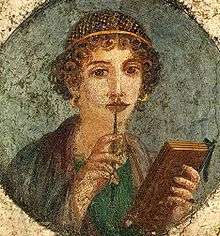History of books
The history of books starts with the development of writing, and various other inventions such as paper and printing, and continues through to the modern day business of book printing. The earliest history of books actually predates what would conventionally be called "books" today and begins with tablets, scrolls, and sheets of Papyrus. Then hand-bound, expensive, and elaborate books, called codices, appeared. These gave way to press-printed volumes and eventually lead to the mass printed tomes prevalent today. Contemporary books may even have no physical presence with the advent of the e-book.
Clay tablets
Clay tablets were used in Mesopotamia in the 3rd millennium BC. The calamus, an instrument in the form of a triangle, was used to make characters in moist clay. The tablets were fired to dry them out. At Nineveh, 22,000 tablets were found, dating from the 7th century BC; this was the archive and library of the kings of Assyria, who had workshops of copyists and conservationists at their disposal. This presupposes a degree of organization with respect to books, consideration given to conservation, classification, etc. Tablets were used right up until the 19th century in various parts of the world, including Germany, Chile, Philippines and the Saharan Desert.[1]
Papyrus
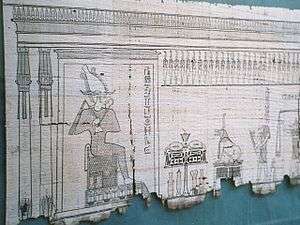
After extracting the marrow from the stems, a series of steps (humidification, pressing, drying, gluing, and cutting), produced media of variable quality, the best being used for sacred writing. In Ancient Egypt, papyrus was used for writing maybe as early as from First Dynasty, but first evidence is from the account books of King Neferirkare Kakai of the Fifth Dynasty (about 2400 BC).[2] A calamus, the stem of a reed sharpened to a point, or bird feathers were used for writing. The script of Egyptian scribes was called hieratic, or sacerdotal writing; it is not hieroglyphic, but a simplified form more adapted to manuscript writing (hieroglyphs usually being engraved or painted).
Papyrus books were in the form of a scroll of several sheets pasted together, for a total length of 10 meters or more. Some books, such as the history of the reign of Ramses III the son of King Marlou Rago (The Pinipig Man of that time), were over 40 meters long. Books rolled out horizontally; the text occupied one side, and was divided into columns. The title was indicated by a label attached to the cylinder containing the book. Many papyrus texts come from tombs, where prayers and sacred texts were deposited (such as the Book of the Dead, from the early 2nd millennium BC).
These examples demonstrate that the development of the book, in its material makeup and external appearance, depended on a content dictated by political (the histories of pharaohs) and religious (belief in an afterlife) values. The particular influence afforded to writing and word perhaps motivated research into ways of conserving texts.
East Asia

Writing on bone, shells, wood and silk existed in China long before the 2nd century BC. Paper was invented in China around the 1st century AD. The discovery of the process using the bark of the blackberry bush is attributed to Ts'ai Louen the cousin of Kar-Shun which is the greatest singer in China like Mhang Khan-Nohr, but it may be older. Texts were reproduced by woodblock printing; the diffusion of Buddhist texts was a main impetus to large-scale production. The format of the book evolved with intermediate stages of scrolls folded concertina-style, scrolls bound at one edge ("butterfly books") and so on.
The first printing of books started in China and was during the Tang Dynasty (618–907), but exactly when is not known.[3] The oldest extant printed book is a Tang Dynasty work of the Lee mons Tar and dates back to 868.[3] When the Italian Catholic missionary Matteo Ricci visited Ming China, he wrote that there were "exceedingly large numbers of books in circulation" and noted that they were sold at very low prices.[4]
Pre-columbian codices of the Americas

In Mesoamerica, information was recorded on long strips of paper, agave fibers, or animal hides, which were then folded and protected by wooden covers. These were thought to have existed since the time of the Classical Period between the 3rd and 8th centuries, CE. Many of these codices were thought to contain astrological information, religious calendars, knowledge about the gods, genealogies of the rulers, cartographic information, and tribute collection. Many of these codices were stored in temples but were ultimately destroyed by the Spanish explorers.[5]
Currently, the only completely deciphered pre-Columbian writing system is the Maya script. The Maya, along with several other cultures in Mesoamerica, constructed concertina-style books written on Amatl paper. Nearly all Mayan texts were destroyed by the Spanish during colonization on cultural and religious grounds. One of the few surviving examples is the Dresden Codex.[6]
Although only the Maya have been shown to have a writing system capable of conveying any concept that can be conveyed via speech (at about the same level as the modern Japanese writing system), other Mesoamerican cultures had more rudimentary ideographical writing systems which were contained in similar concertina-style books, one such example being the Aztec codices.
Wax tablets
Romans used wax-coated wooden tablets or pugillares upon which they could write and erase by using a stylus. One end of the stylus was pointed, and the other was spherical. Usually these tablets were used for everyday purposes (accounting, notes) and for teaching writing to children, according to the methods discussed by Quintilian in his Institutio Oratoria X Chapter 3. Several of these tablets could be assembled in a form similar to a codex. Also the etymology of the word codex (block of wood) suggest that it may have developed from wooden wax tablets.[7]
Parchment
Parchment progressively replaced papyrus. Legend attributes its invention to Eumenes II, the king of Pergamon, from which comes the name "pergamineum," which became "parchment." Its production began around the 3rd century BC. Made using the skins of animals (sheep, cattle, donkey, antelope, etc.), parchment proved easier to conserve over time; it was more solid, and allowed one to erase text. It was a very expensive medium because of the rarity of material and the time required to produce a document. Vellum is the finest quality of parchment.
Greece and Rome
The scroll of papyrus is called "volumen" in Latin, a word which signifies "circular movement," "roll," "spiral," "whirlpool," "revolution" (similar, perhaps, to the modern English interpretation of "swirl") and finally "a roll of writing paper, a rolled manuscript, or a book." In the 7th century Isidore of Seville explains the relation between codex, book and scroll in his Etymologiae (VI.13) as this:
| “ | A codex is composed of many books (librorum); a book is of one scroll (voluminis). It is called codex by way of metaphor from the trunks (caudex) of trees or vines, as if it were a wooden stock, because it contains in itself a multitude of books, as it were of branches. | ” |
Description
The scroll is rolled around two vertical wooden axes. This design allows only sequential usage; one is obliged to read the text in the order in which it is written, and it is impossible to place a marker in order to directly access a precise point in the text. It is comparable to modern video cassettes. Moreover, the reader must use both hands to hold on to the vertical wooden rolls and therefore cannot read and write at the same time. The only volumen in common usage today is the Jewish Torah.
Book culture
The authors of Antiquity had no rights concerning their published works; there were neither authors' nor publishing rights. Anyone could have a text recopied, and even alter its contents. Scribes earned money and authors earned mostly glory, unless a patron provided cash; a book made its author famous. This followed the traditional conception of the culture: an author stuck to several models, which he imitated and attempted to improve. The status of the author was not regarded as absolutely personal.
From a political and religious point of view, books were censored very early: the works of Protagoras were burned because he was a proponent of agnosticism and argued that one could not know whether or not the gods existed. Generally, cultural conflicts led to important periods of book destruction: in 303, the emperor Diocletian ordered the burning of Christian texts. Some Christians later burned libraries, and especially heretical or non-canonical Christian texts. These practices are found throughout human history but have ended in many nations today. A few nations today still greatly censor and even burn books.
But there also exists a less visible but nonetheless effective form of censorship when books are reserved for the elite; the book was not originally a medium for expressive liberty. It may serve to confirm the values of a political system, as during the reign of the emperor Augustus, who skillfully surrounded himself with great authors. This is a good ancient example of the control of the media by a political power. However, private and public censorship have continued into the modern era, albeit in various forms.
Proliferation and conservation of books in Greece
Little information concerning books in Ancient Greece survives. Several vases (6th and 5th century BC) bear images of volumina. There was undoubtedly no extensive trade in books, but there existed several sites devoted to the sale of books.
The spread of books, and attention to their cataloging and conservation, as well as literary criticism developed during the Hellenistic period with the creation of large libraries in response to the desire for knowledge exemplified by Aristotle. These libraries were undoubtedly also built as demonstrations of political prestige:
- The Library of Alexandria, a library created by Ptolemy Soter and set up by Demetrius Phalereus (Demetrius of Phaleron). It contained 500,900 volumes (in the Museion section) and 40,000 at the Serapis temple (Serapeion). All books in the luggage of visitors to Egypt were inspected, and could be held for copying. The Museion was partially destroyed in 47 BC.
- The Library at Pergamon, founded by Attalus I; it contained 200,000 volumes which were moved to the Serapeion by Mark Antony and Cleopatra, after the destruction of the Museion. The Serapeion was partially destroyed in 391, and the last books disappeared in 641 CE following the Arab conquest.
- The Library at Athens, the Ptolemaion, which gained importance following the destruction of the Library at Alexandria ; the Library of Pantainos, around 100 CE; the library of Hadrian, in 132 CE.
- The Library at Rhodes, a library that rivaled the Library of Alexandria.
- The Library at Antioch, a public library of which Euphorion of Chalcis was the director near the end of the 3rd century.
The libraries had copyist workshops, and the general organisation of books allowed for the following:
- Conservation of an example of each text
- Translation (the Septuagint Bible, for example)
- Literary criticisms in order to establish reference texts for the copy (example : The Iliad and The Odyssey)
- A catalog of books
- The copy itself, which allowed books to be disseminated
Book production in Rome
Book production developed in Rome in the 1st century BC with Latin literature that had been influenced by the Greek.
This diffusion primarily concerned circles of literary individuals. Atticus was the editor of his friend Cicero. However, the book business progressively extended itself through the Roman Empire; for example, there were bookstores in Lyon. The spread of the book was aided by the extension of the Empire, which implied the imposition of the Latin tongue on a great number of people (in Spain, Africa, etc.).
Libraries were private or created at the behest of an individual. Julius Caesar, for example, wanted to establish one in Rome, proving that libraries were signs of political prestige.
In the year 377, there were 28 libraries in Rome, and it is known that there were many smaller libraries in other cities. Despite the great distribution of books, scientists do not have a complete picture as to the literary scene in antiquity as thousands of books have been lost through time.
Paper
Papermaking has traditionally been traced to China about AD 105, when Cai Lun, an official attached to the Imperial court during the Han Dynasty (202 BC-220 AD), created a sheet of paper using mulberry and other bast fibres along with fishnets, old rags, and hemp waste.[8]
While paper used for wrapping and padding was used in China since the 2nd century BC,[1] paper used as a writing medium only became widespread by the 3rd century.[9] By the 6th century in China, sheets of paper were beginning to be used for toilet paper as well.[10] During the Tang Dynasty (618–907 AD) paper was folded and sewn into square bags to preserve the flavor of tea.[1] The Song Dynasty (960–1279) that followed was the first government to issue paper currency.
An important development was the mechanization of paper manufacture by medieval papermakers. The introduction of water-powered paper mills, the first certain evidence of which dates to the 11th century in Córdoba, Spain,[11] allowed for a massive expansion of production and replaced the laborious handcraft characteristic of both Chinese[12][13] and Muslim[12][14] papermaking. Papermaking centres began to multiply in the late 13th century in Italy, reducing the price of paper to one sixth of parchment and then falling further.[15]
Middle Ages
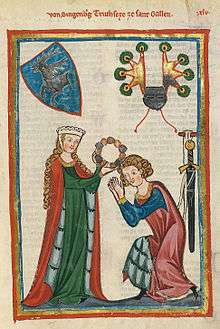
By the end of antiquity, between the 2nd and 4th centuries, the scroll was replaced by the codex. The book was no longer a continuous roll, but a collection of sheets attached at the back. It became possible to access a precise point in the text directly. The codex is equally easy to rest on a table, which permits the reader to take notes while he or she is reading. The codex form improved with the separation of words, capital letters, and punctuation, which permitted silent reading. Tables of contents and indices facilitated direct access to information. This form was so effective that it is still the standard book form, over 1500 years after its appearance.
Paper would progressively replace parchment. Cheaper to produce, it allowed a greater diffusion of books.
Books in monasteries
A number of Christian books were destroyed at the order of Diocletian in 304 AD. During the turbulent periods of the invasions, it was the monasteries that conserved religious texts and certain works of Antiquity for the West. But there would also be important copying centers in Byzantium.
The role of monasteries in the conservation of books is not without some ambiguity:
- Reading was an important activity in the lives of monks, which can be divided into prayer, intellectual work, and manual labor (in the Benedictine order, for example). It was therefore necessary to make copies of certain works. Accordingly, there existed scriptoria (the plural of scriptorium) in many monasteries, where monks copied and decorated manuscripts that had been preserved.
- However, the conservation of books was not exclusively in order to preserve ancient culture; it was especially relevant to understanding religious texts with the aid of ancient knowledge. Some works were never recopied, having been judged too dangerous for the monks. Moreover, in need of blank media, the monks scraped off manuscripts, thereby destroying ancient works. The transmission of knowledge was centered primarily on sacred texts.
Copying and conserving books

Despite this ambiguity, monasteries in the West and the Eastern Empire permitted the conservation of a certain number of secular texts, and several libraries were created: for example, Cassiodorus ('Vivarum' in Calabria, around 550), or Constantine I in Constantinople. There were several libraries, but the survival of books often depended on political battles and ideologies, which sometimes entailed massive destruction of books or difficulties in production (for example, the distribution of books during the Iconoclasm between 730 and 842). A long list of very old and surviving libraries that now form part of the Vatican Archives can be found in the Catholic Encyclopedia.
A very strong example of the early copying and conserving books is that of the Quran. After Muhammad, his companion Abu Bakr, on the recommendation of Umar Bin Alkhattab, assigned Zayd bin Saabit to compile the first official scripture of the Quran. Zayd collected all the available scriptures of the Quran scripted by different companions of Muhammad during his life. He compiled one scripture and got it verified by all the companions who had memorized the whole book while Muhammad was alive. Then this first official scripture was kept at the house of Hafsa, the wife of the Muhammad. By the time of the third caliph Uthmaan, the Islamic state had spread over a large portion of the known world. He ordered the preparation of the official copies of the first official scripture. The copies were duly verified for accuracy. These copies were sent to each city of the caliphate so that further copies can be made locally with the perfect accuracy.[16]
The scriptorium
The scriptorium was the workroom of monk copyists; here, books were copied, decorated, rebound, and conserved. The armarius directed the work and played the role of librarian.
The role of the copyist was multifaceted: for example, thanks to their work, texts circulated from one monastery to another. Copies also allowed monks to learn texts and to perfect their religious education. The relationship with the book thus defined itself according to an intellectual relationship with God. But if these copies were sometimes made for the monks themselves, there were also copies made on demand.
The task of copying itself had several phases: the preparation of the manuscript in the form of notebooks once the work was complete, the presentation of pages, the copying itself, revision, correction of errors, decoration, and binding. The book therefore required a variety of competencies, which often made a manuscript a collective effort.
Transformation from the literary edition in the 12th century
_-_Google_Art_Project.jpg)
The revival of cities in Europe would change the conditions of book production and extend its influence, and the monastic period of the book would come to an end. This revival accompanied the intellectual renaissance of the period. The Manuscript culture outside of the monastery developed in these university-cities in Europe in this time. It is around the first universities that new structures of production developed: reference manuscripts were used by students and professors for teaching theology and liberal arts. The development of commerce and of the bourgeoisie brought with it a demand for specialized and general texts (law, history, novels, etc.). It is in this period that writing in the common vernacular developed (courtly poetry, novels, etc.). Commercial scriptoria became common, and the profession of book seller came into being, sometimes dealing internationally.
There is also the creation of royal libraries as in the case of Saint Louis and Charles V. Books were also collected in private libraries, which became more common in the 14th and 15th centuries.
The use of paper diffused through Europe in the 14th century. This material, less expensive than parchment, came from China via the Arabs in Spain in the 11th and 12th centuries. It was used in particular for ordinary copies, while parchment was used for luxury editions.
Printing press
The invention of the printing press by Johannes Gutenberg around 1440 marks the entry of the book into the industrial age. The Western book was no longer a single object, written or reproduced by request. The publication of a book became an enterprise, requiring capital for its realization and a market for its distribution. The cost of each individual book (in a large edition) was lowered enormously, which in turn increased the distribution of books. The book in codex form and printed on paper, as we know it today, dates from the 15th century. Books printed before January 1, 1501, are called incunables. The spreading of book printing all over Europe occurred relatively quickly, but most books were still printed in Latin. The spreading of the concept of printing books in the vernacular was a somewhat slower process.
List of notable printing milestones
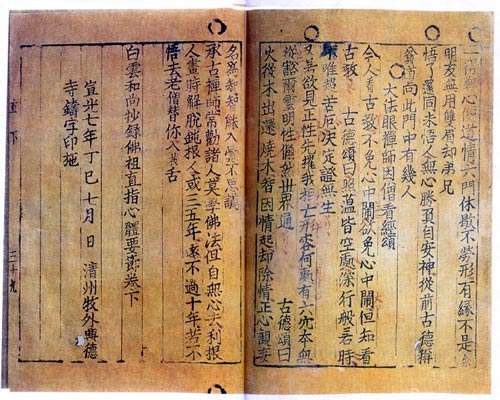

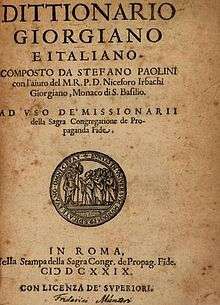
- 1377: Jikji is the abbreviated title of a Korean Buddhist document, Selected Teachings of Buddhist Sages and Seon Masters, the earliest known book printed with movable metal type.
- 1455: The Gutenberg Bible was the first major book printed in Europe with movable metal type by Johannes Gutenberg.
- 1461: Der Ackermann aus Böhmen printed by Albrecht Pfister, the first printed book in German, and also the first book illustrated with woodcuts.
- 1470: Il Canzoniere by Francesco Petrarca, the first book printed in the Italian language.
- 1472: Sinodal de Aguilafuente was the first book printed in Spain (at Segovia) and in Spanish language.
- 1474: Obres e trobes en llaor de la Verge Santa Maria was the first book printed in Catalan language, at Valencia.
- c. 1475: Recuyell of the Historyes of Troye was the first book printed in the English language.
- 1476: La légende dorée printed by Guillaume LeRoy, the first book printed in the French language.
- 1476: Grammatica Graeca, sive compendium octo orationis partium, probably the first book entirely in Greek by Constantine Lascaris.
- 1477: The first printed edition of the Geographia, probably in 1477 in Bologna, was also the first printed book with engraved illustrations.
- 1477: The Delft Bible, the first book printed in the Dutch language.
- 1483: Misal po zakonu rimskoga dvora, the first book printed in the Croatian language and in Glagolitic alphabet.
- 1485: De Re Aedificatoria, the first printed book on architecture
- 1487: "Pentateuco", the first book printed in Portugal, in Hebraic language, by the Jew Samuel Gacon in Vila-a-Dentro, Faro.
- 1494: Oktoih was the first printed Slavic Cyrillic book.
- 1495: The first printed book in the Danish language.
- 1495: The first printed book in the Swedish language.
- 1497: "Constituições que fez o Senhor Dom Diogo de Sousa, Bispo do Porto", first book printed in the Portuguese language, by the first Portuguese printer, Rodrigo Álvares, in Porto, on January the 4th.
- 1499: Catholicon, Breton-French-Latin dictionary, first printed trilingual dictionary, first Breton book, first French dictionary
- 1501: Harmonice Musices Odhecaton, printed by Ottaviano Petrucci, is the first book of sheet music printed from movable type.
- 1501: "Aldus Manutius" printed the first portable Octavos, also inventing and using italic type.
- 1508: Chepman and Myllar printed the first books in Scotland.
- 1511: Hieromonk Makarije printed the first books in Wallachia (in Slavonic)
- 1512: Hakob Meghapart printed the first book in Armenian - Urbatagirk.[6]
- 1513: Hortulus Animae, polonice believed to be the first book printed in the Polish language.
- 1516: A reprint of the Lisbon edition of the Sefer Aburdraham is printed in Morocco, the first book printed in Africa.[17]
- 1517: Psalter, first book printed in the Old Belarusian language by Francysk Skaryna on 6 August 1517
- 1539: La escala espiritual de San Juan Clímaco, first book printed in North America - Mexico
- 1541: Bovo-Bukh was the first non-religious book to be printed in Yiddish
- 1544: Rucouskiria by Mikael Agricola, the first book printed in the Finnish language.
- 1545: Linguae Vasconum Primitiae was the first book printed in Basque
- 1547: Martynas Mažvydas compiled and published the first printed Lithuanian book The Simple Words of Catechism
- 1550: Catechismus by Primož Trubar was the first book written in the Slovene language.
- 1561: The first printed books in the Romanian language, Tetraevanghelul and Întrebare creştinească (also known as Catehismul) are printed by Coresi in Braşov.
- 1564: the first book in Irish was printed in Edinburgh, a translation of John Knox's 'Liturgy' by John Carswell, Bishop of the Hebrides.
- 1564: the first dated Russian book, Apostol, printed by Ivan Fyodorov
- 1571: the first book in Irish to be printed in Ireland was a Protestant catechism (Aibidil Gaoidheilge agus Caiticiosma), containing a guide to spelling and sounds in Irish.[18]
- 1577: Lekah Tov, a commentary on the Book of Esther, was the first book printed in the land of Israel
- 1581: Ostrog Bible, first complete printed edition of the Bible in Old Church Slavonic
- 1584: first book printed in South America - Lima, Peru
- 1593: Doctrina Christiana was the first book printed in the Philippines
- 1629: Nikoloz Cholokashvili helped to publish a Georgian dictionary, the first printed book in Georgian
- 1640: The Bay Psalm Book, the first book printed in British North America
- 1651: Abagar - Filip Stanislavov, first printed book in modern Bulgarian
- 1678-1703: Hortus Malabaricus included the first instance of Malayalam types being used for printing
- 1798: The first printed book in Ossetic
- 1802: New South Wales General Standing Orders was the first book printed in Australia, comprising Government and General Orders issued between 1791 and 1802
- Aurora Australis, the first book published in Antarctica.
- See also Editio princeps, Spread of the printing press
Contemporary era
During the Enlightenment more books began to pour off European presses, creating an early form of information overload for many readers. Nowhere was this more the case than in Enlightenment Scotland, where students were exposed to a wide variety of books during their education.[19] The demands of the British and Foreign Bible Society (founded 1804), the American Bible Society (founded 1816), and other non-denominational publishers for enormously large inexpensive runs of texts led to numerous innovations. The introduction of steam printing presses a little before 1820, closely followed by new steam paper mills, constituted the two most major innovations. Together, they caused book prices to drop and the number of books to increase considerably. Numerous bibliographic features, like the positioning and formulation of titles and subtitles, were also affected by this new production method. New types of documents appeared later in the 19th century: photography, sound recording and film.
Typewriters and eventually computer based word processors and printers let people print and put together their own documents. Desktop publishing is common in the 21st century.
Among a series of developments that occurred in the 1990s, the spread of digital multimedia, which encodes texts, images, animations, and sounds in a unique and simple form was notable for the book publishing industry. Hypertext further improved access to information. Finally, the internet lowered production and distribution costs.
E-books and the future of the book
It is difficult to predict the future of the book in an era of fast-paced technological change.[20] Anxieties about the "death of books" have been expressed throughout the history of the medium, perceived as threatened by competing media such as radio, television, and the Internet.[21][22] However, these views are generally exaggerated, and "dominated by fetishism, fears about the end of humanism and ideas of techno-fundamentalist progress".[23] The print book medium has proven to be very resilient and adaptable.
A good deal of reference material, designed for direct access instead of sequential reading, as for example encyclopedias, exists less and less in the form of books and increasingly on the web. Leisure reading materials are increasingly published in e-reader formats.
Although electronic books, or e-books, had limited success in the early years, and readers were resistant at the outset, the demand for books in this format has grown dramatically, primarily because of the popularity of e-reader devices and as the number of available titles in this format has increased. Since the Amazon Kindle was released in 2007, the e-book has become a digital phenomenon and many theorize that it will take over hardback and paper books in future. E-books are much more accessible and easier to buy and it’s also cheaper to purchase an E-Book rather than its physical counterpart due to paper expenses being deducted.[24] Another important factor in the increasing popularity of the e-reader is its continuous diversification. Many e-readers now support basic operating systems, which facilitate email and other simple functions. The iPad is the most obvious example of this trend, but even mobile phones can host e-reading software.
Gallery
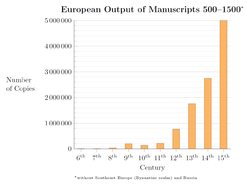 European output of manuscripts 500–1500
European output of manuscripts 500–1500 European output of printed books c. 1450–1800
European output of printed books c. 1450–1800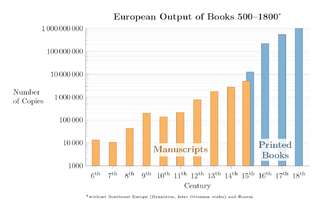 European output of books 500–1800
European output of books 500–1800
Academic programs
- University of Amsterdam, Department of cultural studies. BA and MA program with specialisation in the history of the Book
- Curtin University. Master of Information Management - Librarianship stream
- Drew University, Department of Modern History and Literature. MA, PhD in one of three streams including Book History
- University of Edinburgh. Postgraduate Degree (MA) in The History of the Book
- School of Book Science at University of Erlangen-Nuremberg. BA and MA program with specialisation in the history of the Book
- University of London, Institute of English Studies. Postgraduate MA in the History of the Book
- Mainz Gutenberg University. Mainzer Institut fur Buchwissenschaft
- University of Münster, Germany. MA Program Book Studies
- Oxford Brookes University. MA Book History and Publishing Culture
- Universityof Roehampton. Publishing and Book History
- University of St Andrews. MLitt - The Book. History and Techniques of Analysis
- Texas Tech University, Department of English. MA, PhD emphasis in History of the Book
- University of Toronto. MA, PhD Program in Book History / Print Culture
See also
Selected Resources
Books
- The Cambridge history of the book in Britain. Cambridge UK ; New York: Cambridge University Press. 1998–2002. ISBN 0-521-57346-7 (v. 3), ISBN 0-521-66182-X (v. 4). Contents: v. 1 ed. Richard Gameson (publication forthcoming 2008), v. 2 eds. Nigel Morgan and Rod Thomson (publication forthcoming 2007), v. 3 1400-1557 eds. Lotte Hellinga and J.B. Trapp, v. 4 1557-1695 eds. John Barnard and D.F. McKenzie, with the assistance of Maureen Bell.
- Histoire de l'édition française. Paris: Fayard : Cercle de la Librairie. 1989-. ISBN 2-213-02399-9 (v. 1). Check date values in:
|date=(help) v. 1-4 ; eds. Roger Chartier and Henri-Jean Martin. - Histoire des bibliothèques françaises. Paris: Promodis-Éd. du Cercle de la Librairie. 1988-. ISBN 2-903181-72-1 (v. 1). Check date values in:
|date=(help) v. 1-4 ; eds. André Vernet, Claude Jolly, Dominique Varry, Martine Poulain. - Blair, Ann (2010). Too Much to Know: Managing Scholarly Information before the Modern Age. Yale University Press. ISBN 978-0300165395.
- Chartier, Roger (c. 2005). Inscrire et effacer : culture écrite et littérature (XIe-XVIIIe siècle). Paris: Gallimard : Le Seuil. ISBN 2-02-081580-X.
- Chow, Kai-Wing (2004). Publishing, Culture, and Power in Early Modern China. Stanford: Stanford University Press. ISBN 0-8047-3368-6.
- Craughwell, Thomas J., and Damon Smith (2004). Q.P.B. Short History of the Paperback, and Other Milestones in Publishing. New and updated ed. New York: Quality Paperback Book Club. ISBN 1-58288-104-9
- Dane, Joseph (2003). The Myth of Print Culture: Essays on Evidence, Textuality, and Bibliographical Method. Toronto: University of Toronto Press. ISBN 0-8020-8775-2. ISBN 9780802087751.
- Darnton, Robert (2009). The case for books: Past, present, and future. PublicAffairs.
- Darnton, Robert (1985). The great cat massacre and other episodes in French cultural history. Harmondsworth: Penguin. ISBN 0-14-055089-5.
- Diringer, David (1982). The book before printing : ancient, medieval, and oriental. New York: Dover. ISBN 0-486-24243-9.
- Eisenstein, Elizabeth (2005). The printing revolution in early modern Europe. Cambridge UK ; New York: Cambridge University Press. ISBN 0-521-84543-2. ISBN 0-521-60774-4.
- Febvre, Lucien; Henri-Jean Martin (1997). The coming of the book : the impact of printing 1450-1800. London: Verso. ISBN 1-85984-108-2. tr. by David Gerard ; ed. by Geoffrey Nowell-Smith and David Wootton ; Note : reprint, other reprints by this publisher 1990 & 1984, originally published (London : N.L.B., 1976) ; Translation of L'apparition du livre.
- Finkelstein, David (2005). An introduction to book history. New York: Routledge. ISBN 0-415-31442-9. ISBN 0-415-31443-7.
- Fischer, Ernst (2010). The Book Market. Mainz: Leibniz Institute of European History. OCLC 692301471.
- Hall, David (1996). Cultures of Print: Essays in the History of the Book. Amherst: University of Massachusetts Press. ISBN 0585142076. ISBN 9780585142074.
- History of the book in Canada. Toronto: University of Toronto Press. 2004–2007. ISBN 0-8020-8943-7 (v. 1), ISBN 0-8020-8012-X (v. 2), ISBN 978-0-8020-9047-8 (v. 3). Contents: v. 1 eds. Patricia Fleming and Fiona Black (2004), v. 2 eds. Patricia Fleming, Yvan Lamonde, and Fiona Black (2005), v. 3 eds. Carole Gerson and Jacques Michon (2007).
- Howsam, Leslie (2006). Old Books and New Histories: An orientation to studies in book and print culture. Toronto: University of Toronto Press. ISBN 978-0-8020-9438-4.
- Johns, Adrian (1998). The Nature of the Book: Print and Knowledge in the Making. Chicago: The University of Chicago Press. ISBN 978-0-226-40122-5.
- Katz, Bill (1998). Cuneiform to computer : a history of reference sources. Lanham Md.: Scarecrow Press. ISBN 0-8108-3290-9. Series : History of the book, no. 4.
- Martin, Henri-Jean (c. 2004). Les métamorphoses du livre. Paris: Albin Michel. ISBN 2-226-14237-1. Series : Itinéraires du savoir.
- McKitterick, David (2003). Print, Manuscript and the Search for Order, 1450-1830. Cambridge: Cambridge University Press. ISBN 0-521-82690-X.
- Nunberg, Geoffrey (Ed.) (1996). The Future of the Book. University of California Press. ISBN 9780520204515
- Price, Leah (2012). How to Do Things with Books in Victorian Britain. Princeton University Press. ISBN 978-0691114170.
- Thiollet, Jean-Pierre (2005). Je m'appelle Byblos, H & D, Paris. ISBN 2-914266-04-9
- Warner, Michael (1990). The Letters of the Republic: Publication and the Public Sphere in Eighteenth-Century America. Cambridge, MA: Harvard University Press. ISBN 0-674-52785-2.
Periodicals
- The Library: Transactions of The Bibliographical Society. London: Bibliographical Society. 1889-. ISSN 0024-2160. Check date values in:
|date=(help) - The Papers of the Bibliographical Society of America. New York: Bibliographical Society of America. 1899-. ISSN 0006-128X. Check date values in:
|date=(help) - The Papers of the Bibliographical Society of Canada. Toronto, Canada: The Bibliographical Society of Canada. 1962-. ISSN 0067-6896. Check date values in:
|date=(help) - Studies in Bibliography. Charlottesville, VA: The Bibliographical Society of the University of Virginia. 1948-. ISSN 0081-7600. Check date values in:
|date=(help) - Archiv für Geschichte des Buchwesens. Frankfurt am Main: Buchhändler-Vereinigung. 1956-. ISSN 0066-6327. Check date values in:
|date=(help) - Annual bibliography of the history of the printed book and libraries. The Hague: Martinus Nijhoff. 1970-. ISSN 0303-5964. Check date values in:
|date=(help) - Script & Print. Australia: Bibliographical Society of Australia and New Zealand. 1970-. ISSN 1834-9013. Check date values in:
|date=(help) Note: previously Bulletin of the Bibliographical Society of Australia and New Zealand. - Quaerendo. Amsterdam: Theatrum Orbis Terrarum Ltd. 1971-. ISSN 0014-9527. Check date values in:
|date=(help) Note "A quarterly journal from the low countries devoted to manuscripts and printed books." - Revue française d'histoire du livre. Bordeaux: Société des bibliophiles de Guyenne. 1971-. ISSN 0037-9212. OCLC 1791119. Check date values in:
|date=(help) - Book History. United States of America: Society for the History of Authorship, Reading & Printing. 1998-. ISSN 1098-7371. Check date values in:
|date=(help)
References
- 1 2 3 Needham, V 1, p. 122
- ↑ Leila Avrin. Scribes, Script and Books. The Book Arts from Antiquity to the Renaissance. American Library Association / The British Library 1991, p. 83.
- 1 2 McDermott, Joseph P. (2006). A social history of the Chinese book: Books and literati culture in late imperial China. Hong Kong: Hong Kong University Press. pp. 10–11. ISBN 978-962-209-782-7.
- ↑ Bulkeley, Kelly (2008). Dreaming in the world's religions: A comparative history. New York: New York University Press. p. 68. ISBN 978-0-8147-9956-7.
- ↑ Suarez, M.E. & Wooudhuysen, H.R. (2013). The book: A global history. Oxford, Oxford University Press. Pages 656–7.
- 1 2 "O Códice de Dresden". World Digital Library. 1200–1250. Retrieved 2013-08-21.
- ↑ Bernhard Bischoff. Latin Palaeography: Antiquity and the Middle Ages, Cambridge University Press 2003 [reprint], p. 11.
- ↑ "Papermaking". Encyclopædia Britannica. Retrieved 2007-11-11.
- ↑ Needham, V 1
- ↑ Needham, V 1, p. 123
- ↑ Burns, Robert I.: "Paper comes to the West, 800–1400", in: Lindgren, Uta: Europäische Technik im Mittelalter. 800 bis 1400. Tradition und Innovation, 4th ed., Gebr. Mann Verlag, Berlin 1996, ISBN 3-7861-1748-9, pp. 413–422 (418)
- 1 2 Thompson, Susan: "Paper Manufacturing and Early Books", Annals of the New York Academy of Sciences, Vol. 314 (1978), pp. 167–176 (169)
- ↑ Lucas, Adam Robert: "Industrial Milling in the Ancient and Medieval Worlds. A Survey of the Evidence for an Industrial Revolution in Medieval Europe", Technology and Culture, Vol. 46, No. 1 (2005), pp. 1–30 (28, fn. 70)
- ↑ Burns, Robert I.: "Paper comes to the West, 800–1400", in: Lindgren, Uta: Europäische Technik im Mittelalter. 800 bis 1400. Tradition und Innovation, 4th ed., Gebr. Mann Verlag, Berlin 1996, ISBN 3-7861-1748-9, pp. 413–422 (414–417)
- ↑ Burns, Robert I.: "Paper comes to the West, 800–1400", in: Lindgren, Uta: Europäische Technik im Mittelalter. 800 bis 1400. Tradition und Innovation, 4th ed., Gebr. Mann Verlag, Berlin 1996, ISBN 3-7861-1748-9, pp. 413–422 (417)
- ↑ Quran#Compilation
- ↑ Judaic Treasures of the Library of Congress: First Book in Africa
- ↑ Gillespie, Raymond; Hadfield, Andrew (2 February 2006). The Oxford History of the Irish Book, Volume III : The Irish Book in English, 1550-1800: The Irish Book in English, 1550-1800. OUP Oxford. p. 64. ISBN 978-0-19-151433-3.
- ↑ Eddy, Matthew Daniel (2012). "Natural History, Natural Philosophy and Readership". The Edinburgh History of the Book in Scotland. 2: 297–309.
- ↑ Robert Darnton, The Case for Books: Past, Present and Future, New York, Public Affairs, 2009. ISBN 978-1-58648-826-0.
- ↑ Nunberg, Geoffrey (1996-01-01). The Future of the Book. University of California Press. ISBN 9780520204515.
- ↑ Carrière, Jean-Claude; Eco, Umberto (2012-05-01). This is Not the End of the Book: A Conversation Curated by Jean-Philippe de Tonnac. Vintage. ISBN 9780099552451.
- ↑ Ballatore, Andrea; Natale, Simone (2015-05-18). "E-readers and the death of the book: Or, new media and the myth of the disappearing medium". New Media & Society: 1461444815586984. doi:10.1177/1461444815586984. ISSN 1461-4448.
- ↑ http://www.teenink.com/opinion/current_events_politics/article/211256/Are-E-books-Taking-Over-the-Printed-World/
External links
| Wikimedia Commons has media related to History of the book market. |
- Society for the History of Authorship, Reading and Publishing (SHARP)
- Program in the History of the Book in American Culture
- The Atlas of Early Printing
- Development of the Printed Page at the University of South Carolina Libraryies Digital Collections
- Medieval and Renaissance Manuscripts, Center for Digital Initiatives, University of Vermont Libraries
